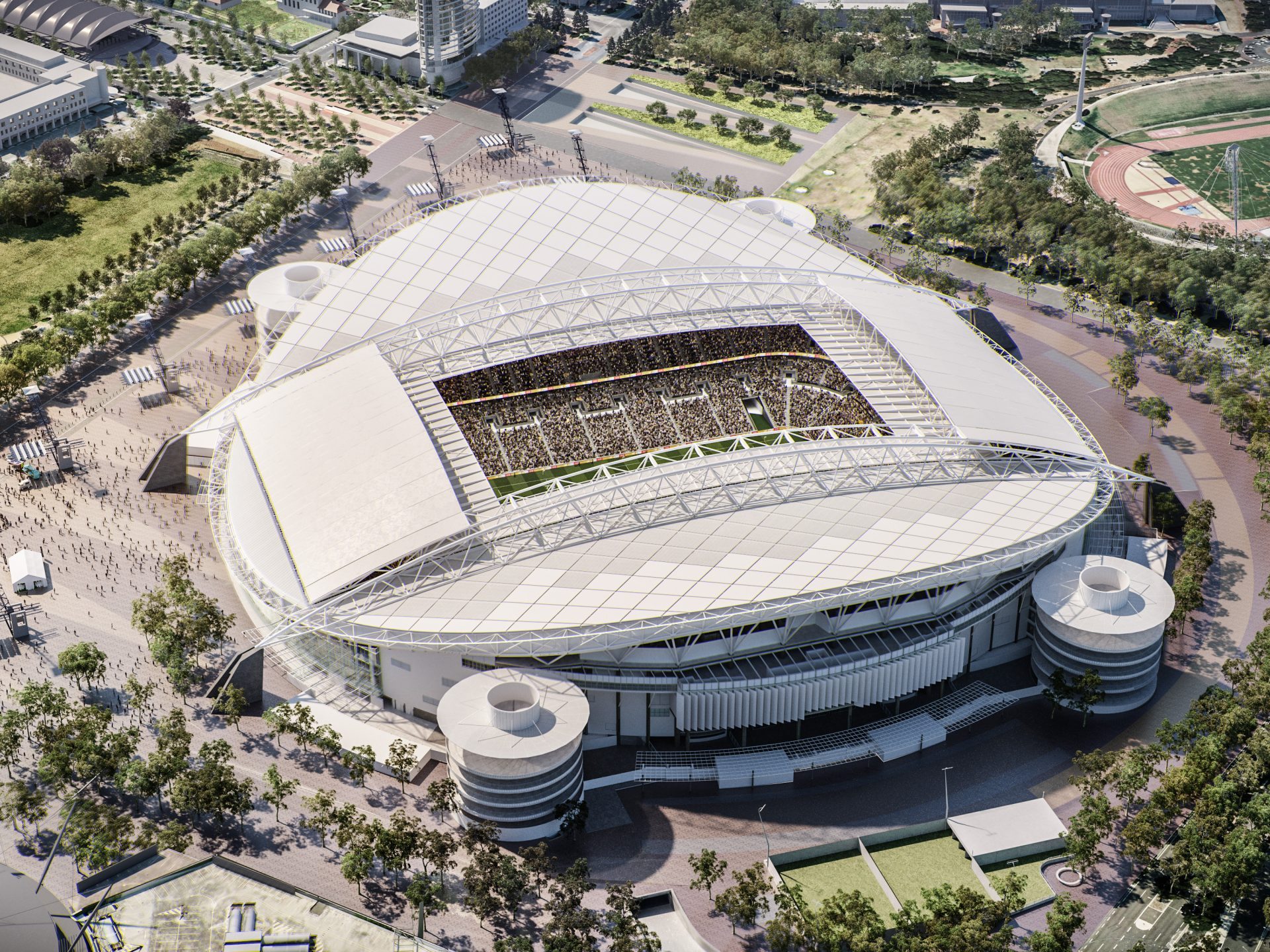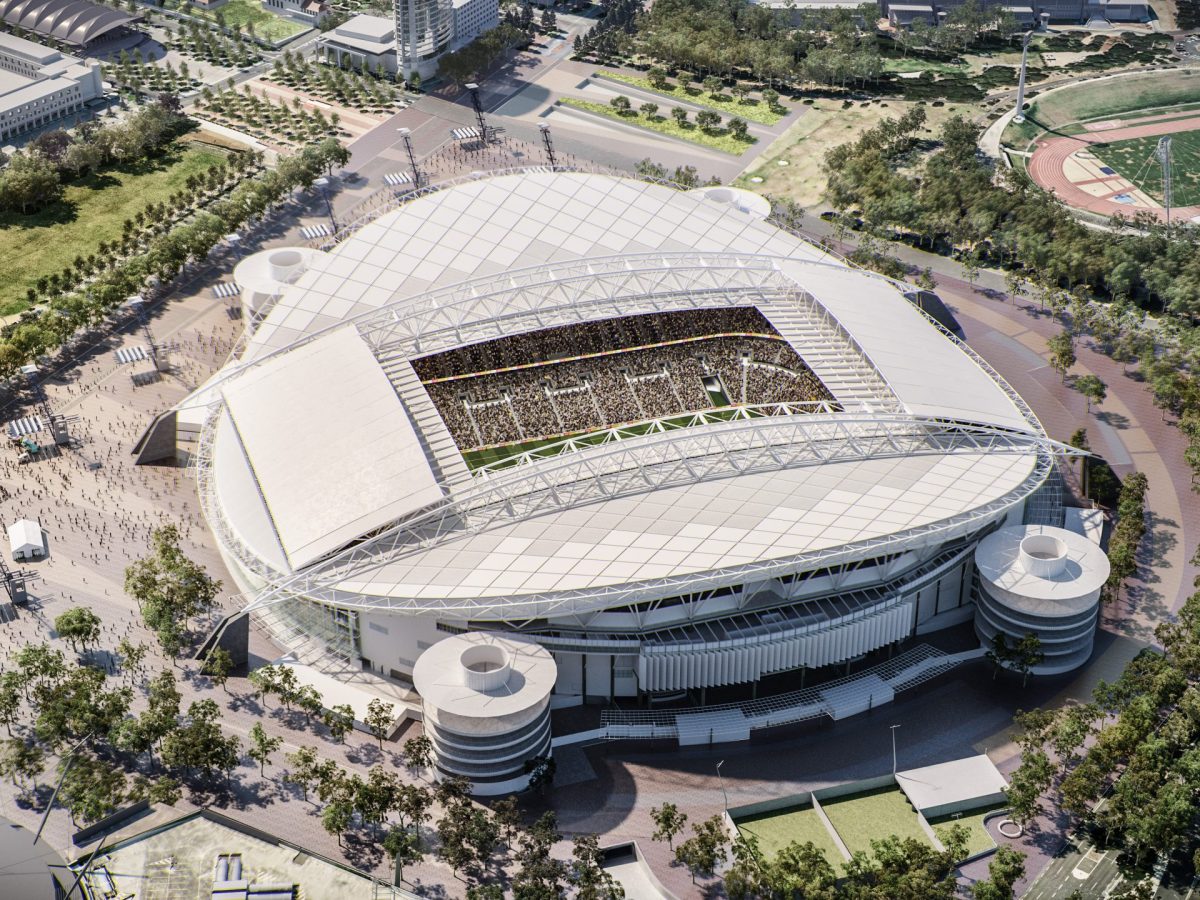August 2, 2024
Stadium Australia Redevelopment: The Potential of Adaptive Reuse

In 2018, the New South Wales (NSW) government initiated a tender for the redevelopment of Populous-designed Stadium Australia, also known as ANZ Stadium and more recently Accor Stadium. Originally built as the Olympic Stadium, it had several components that were either at the end of their life or approaching it which included technology systems, the roof, and the screens. Even the initial use of the stadium had reached end of life: the Olympic stadium’s oval configuration with movable east and west stands made it suitable for a wider range of sports, including athletics and cricket. However, the stadium was to be converted into a rectangular format to better serve the needs of its primary users: Rugby Union, Rugby League, and Soccer. The design intent was, thus, to enhance the spectator experience for rectangular sports by bringing spectators closer to the field and improving hospitality and food and beverage services. The project aimed to redesign the interior while maintaining the essential structural elements where the major maintenance work was estimated at around $100 million.
Populous won the tender with team led by Chris Paterson and Al Baxter and supported by Andrew Crutcher, Peter Charter, Belinda Goh, Paul Foskett, Andrew Wallace, and Christina Kim. They were supported by Maffeis for the structural engineering and Aurecon for MEP systems. Key aspects of the redevelopment were the design-engineering ethos of the team with an emphasis on sustainable design.
Design and Engineering
The key design considerations included:
- Preservation of the Stadium’s Olympic heritage and iconic status, which required retaining the existing roof form and exterior elevation while enhancing connectivity and ventilation through-out the structure.
- The seating bowl was reconfigured around a rectangular field, bringing 50,000 seats closer to the field in sports mode and the stage in concert mode. The lower tier of 25,000 seats was designed to be closer to the field of play than Suncorp Stadium. The aim was to create an extraordinary atmosphere for rectangular sports with a coliseum effect with a surround of people and sound.
- The roof would cover was designed to cover100% of the seats with the option of installing an operable roof later to future-proof it for climate change of increased heat days and rain events.
- Open concourse terraces to the north and south ends were designed to connect spectators to bars, food courts, and views of the field of play.
- The basement, which largely worked well, would remain mostly unchanged except for upgraded changing rooms and better facilities for event staff.
Adaptive Reuse and Structural Ingenuity
A bonus for the redevelopment project team was that it had original team members who were involved in the design of Stadium Australia for the Sydney Olympics 2000. It enabled a process of reuse of materials – but for materials that were unseen. Stephen Morley, the original structural engineer of Maffeis, indicated the presence of “hidden” foundations and inground concrete through existing drawings of the stadium. This find enabled the design team to design for 90% reuse of the existing concrete in the stadium (by weight) achieving significant reductions in cost, time and embodied carbon. This approach highlighted the importance of thorough investigation and understanding of existing structures in large-scale projects.
Sustainability and Efficiency
The design team wanted to ensure that the sustainable legacy of the stadium was maintained due to its legacy as the home of the Sydney 2000 Olympics green games. The project aimed to achieve a Green Star 5-star Performance rating, building on the stadium’s original design features like naturally ventilated concourses, and rainwater harvesting. Aurecon, our MEP and ESD partner on the project, conducted an initial analysis and identified several inefficiencies. One such identified issue was the excessive non-event day electricity usage which was due to continuous operation of non-essential cool rooms and lack of sensors for lighting and air conditioning. An answer to this was smart strategies of keeping the critical cool rooms that housed perishables switched on while all others would be switched off. Thus, a key lesson was the importance of auditing existing venues to not only bring them up to code but also identify avenues of energy savings.
Community Asset
Every effort was made to integrate the redevelopment project with the surrounding precinct. Rainwater from the stadium’s large roof area would continue to be harvested towards a recycled water loop which would serve the precinct’s non-potable purposes. In a similar vein, the project included plans to install photovoltaic (PV) panels on an adjacent car park, providing renewable energy to the stadium and surrounding buildings. Thus, the redevelopment was not only going to bring people to experience entertainment and sports but also give back tangible resources back to the local community.
Sustainable Stadia Expertise
The design for the Stadium Australia redevelopment set a new standard for sustainable and efficient stadium design. Ultimately the project was put on hold due to COVID-19 pandemic but nevertheless provided significant lessons for the design teams and client in sustainable adaptive reuse of sporting infrastructure. A key aspect of the design process was having Populous and Maffeis bring their in-depth knowledge of Stadium Australia to determine strategies that would enable efficient material use which in turn facilitated significant embodied carbon reduction. While the redevelopment ultimately did not proceed, Populous remains closely involved in preserving and improving Stadium Australia for the future. For the 2023 FIFA Women’s World Cup, Populous led a major overhaul of the stadium’s four dressing rooms to bring them up to modern standards and, importantly, make them gender neutral.
Populous further continues to advise the stadium operators regularly, particularly for major international and domestic sporting and entertainment events, including the record-breaking visit by US artist Taylor Swift for her Eras Tour in February 2023 – the four biggest days in the stadium’s history since the 2000 Olympics.
Stadium Australia holds a special place in world sport as the only venue to have hosted an Olympics opening ceremony, Rugby World Cup (2003) and FIFA World Cup (2023).
Lorem ipsum dolor sit amet consectetur, adipisicing elit. Non facere corporis et expedita sit nam amet aut necessitatibus at dolore enim quis impedit eius libero, harum tempore laboriosam dolor cumque.
Lorem, ipsum dolor sit amet consectetur adipisicing elit. Illo temporibus vero veritatis eveniet, placeat dolorem sunt at provident tenetur omnis, dicta exercitationem. Expedita quod aspernatur molestias eum? Totam, incidunt quos.




